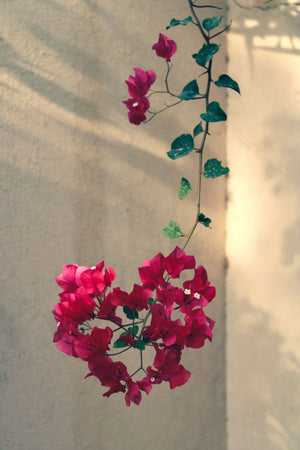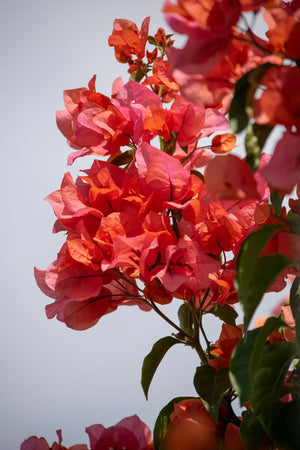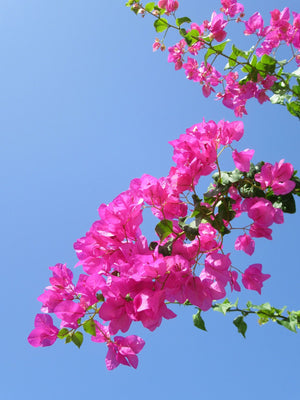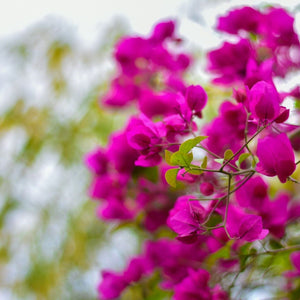The Bougainvillea Guide
Bougainvillea is a vibrant, fast-growing tropical vine known for its brilliant, long-lasting bracts that resemble flowers. Native to South America, this heat-loving plant is a favorite for adding bold color to gardens, patios, and trellises. Whether trained as a climber, grown as a container plant, or shaped into a shrub, Bougainvillea is a spectacular choice for warm-climate gardens. Here’s everything you need to know about growing and caring for Bougainvillea.

About
Bougainvillea is a genus of woody, flowering plants in the Nyctaginaceae family, prized for their colorful bracts that surround small, inconspicuous flowers. These bracts come in shades of pink, purple, red, orange, white, and yellow, making Bougainvillea a stunning addition to landscapes.
Popular varieties include Bougainvillea 'Barbara Karst', a vigorous red-flowered selection; Bougainvillea 'Blueberry Ice', a variegated-leaf variety with lavender bracts; and Bougainvillea 'Moneth', a striking magenta-colored cultivar. These plants are known for their rapid growth and ability to withstand drought, making them an excellent low-maintenance choice for tropical and subtropical climates.
Bougainvillea thrives in full sun and warm temperatures, making it ideal for USDA Hardiness Zones 9-11. In cooler climates, it can be grown in containers and overwintered indoors. With proper care and pruning, this plant can be trained as a vine, shrub, or even a small tree.

PLANTING
- USDA Hardiness Zones: Best suited for Zones 9-11; can be grown in containers in colder regions.
- Soil: Prefers well-drained, sandy, or loamy soil with a slightly acidic to neutral pH.
- Sunlight: Requires full sun (at least 6 hours per day) for optimal blooming.
- Watering: Drought-tolerant once established. Water deeply but infrequently, allowing the soil to dry between waterings.
- Spacing: Space plants 3-5 feet apart when growing in the ground. For containers, use well-draining pots with ample space for roots to expand.
- Planting Time: Outdoor Planting - Best planted in spring after the last frost. Containers - Can be planted anytime but should be moved indoors before temperatures drop below 50°F.
To plant Bougainvillea, dig a hole twice as wide as the root ball, set the plant at the same depth as in its container, and backfill with soil. Water thoroughly after planting.

CARE
- Watering: Water deeply every 7-14 days. Avoid overwatering, as Bougainvillea prefers dry conditions between waterings.
- Fertilizing: Apply a balanced, slow-release fertilizer monthly during the growing season to promote blooms.
- Pruning: Regular pruning encourages bushier growth and enhances flowering. Remove dead or weak branches after each bloom cycle.
- Pests & Diseases: Generally pest-resistant but may attract aphids, spider mites, or caterpillars. Treat infestations with insecticidal soap if needed.
- Winter Care: In colder climates, move container-grown plants indoors and reduce watering to prevent root rot.

HOW TO USE
Bougainvillea’s brilliant color and vigorous growth make it a versatile choice for various landscape applications:
- Climbing Vines: Train on trellises, pergolas, and fences for a cascading floral display.
- Container Gardening: Perfect for patios and balconies; can be overwintered indoors in colder zones.
- Hedges & Borders: Can be pruned into dense, colorful hedges in tropical regions.
- Ground Cover: Sprawling varieties provide excellent coverage for slopes and garden beds.
- Bonsai & Small Trees: With careful pruning, Bougainvillea can be shaped into compact trees or bonsai specimens.

Common Questions
- How to prune Bougainvillea? Prune after flowering to encourage new growth and more blooms. Trim back weak or leggy stems to maintain shape.
- How to propagate Bougainvillea? Take semi-hardwood cuttings in spring or summer, dip in rooting hormone, and plant in well-draining soil.
- How to care for Bougainvillea? Provide full sun, occasional deep watering, and light pruning. Avoid excessive fertilization, which can reduce flowering.
- Is Bougainvillea poisonous to dogs? Bougainvillea is not highly toxic but can cause mild irritation if ingested.
- Is Bougainvillea poisonous to cats? Like with dogs, ingestion may cause mild stomach upset but is not considered highly toxic.
- Do deer like Bougainvillea? No, Bougainvillea is deer-resistant due to its tough, thorny stems.
- Does Bougainvillea have thorns? Yes, most Bougainvillea species have sharp thorns, so handle with care.
- How fast does Bougainvillea grow? Bougainvillea can grow 3-5 feet per year under optimal conditions.
Conclusion
Bougainvillea is a spectacular, sun-loving plant that brings bold color and energy to any garden. Whether grown as a vine, hedge, or container plant, its long-lasting bracts and vigorous growth make it a standout addition to warm-climate landscapes. With varieties like Bougainvillea 'Barbara Karst', Bougainvillea 'Blueberry Ice', and Bougainvillea 'Moneth', there’s a perfect Bougainvillea for every space. Explore our collection and enjoy the vibrant beauty of this tropical favorite.
The Bougainvillea Collection
Sold Out
Sold Out
Sold Out



